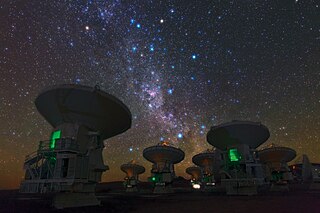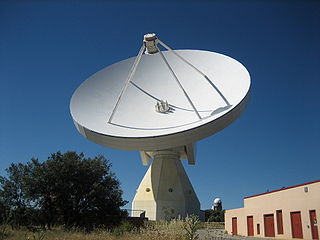
A radio telescope is a specialized antenna and radio receiver used to detect radio waves from astronomical radio sources in the sky. Radio telescopes are the main observing instrument used in radio astronomy, which studies the radio frequency portion of the electromagnetic spectrum emitted by astronomical objects, just as optical telescopes are the main observing instrument used in traditional optical astronomy which studies the light wave portion of the spectrum coming from astronomical objects. Unlike optical telescopes, radio telescopes can be used in the daytime as well as at night.

Very-long-baseline interferometry (VLBI) is a type of astronomical interferometry used in radio astronomy. In VLBI a signal from an astronomical radio source, such as a quasar, is collected at multiple radio telescopes on Earth or in space. The distance between the radio telescopes is then calculated using the time difference between the arrivals of the radio signal at different telescopes. This allows observations of an object that are made simultaneously by many radio telescopes to be combined, emulating a telescope with a size equal to the maximum separation between the telescopes.

The Karl G. Jansky Very Large Array (VLA) is a centimeter-wavelength radio astronomy observatory in the southwestern United States. It lies in central New Mexico on the Plains of San Agustin, between the towns of Magdalena and Datil, approximately 50 miles (80 km) west of Socorro. The VLA comprises twenty-eight 25-meter radio telescopes deployed in a Y-shaped array and all the equipment, instrumentation, and computing power to function as an interferometer. Each of the massive telescopes is mounted on double parallel railroad tracks, so the radius and density of the array can be transformed to adjust the balance between its angular resolution and its surface brightness sensitivity. Astronomers using the VLA have made key observations of black holes and protoplanetary disks around young stars, discovered magnetic filaments and traced complex gas motions at the Milky Way's center, probed the Universe's cosmological parameters, and provided new knowledge about the physical mechanisms that produce radio emission.

Parkes Observatory is a radio astronomy observatory, located 20 kilometres (12 mi) north of the town of Parkes, New South Wales, Australia. It hosts Murriyang, the 64 m CSIRO Parkes Radio Telescope also known as "The Dish", along with two smaller radio telescopes. The 64 m dish was one of several radio antennae used to receive live television images of the Apollo 11 Moon landing. Its scientific contributions over the decades led the ABC to describe it as "the most successful scientific instrument ever built in Australia" after 50 years of operation.

Onsala Space Observatory (OSO), the Swedish National Facility for Radio Astronomy, provides scientists with equipment to study the Earth and the rest of the Universe. The observatory operates two radio telescopes in Onsala, 45 km south of Gothenburg, and takes part in several international projects. Examples of activities:
The Joint Institute for Very Long Baseline Interferometry European Research Infrastructure Consortium (JIVE) was established by a decision of the European Commission in December 2014, and assumed the activities and responsibilities of the JIVE foundation, which was established in December 1993. JIVE's mandate is to support the operations and users of the European VLBI Network (EVN), in the widest sense.

HALCA, also known for its project name VSOP, the code name MUSES-B, or just Haruka (はるか) was a Japanese 8 meter diameter radio telescope satellite which was used for Very Long Baseline Interferometry (VLBI). It was the first such space-borne dedicated VLBI mission.

Haystack Observatory is a multidisciplinary radio science center, ionospheric observatory, and astronomical microwave observatory owned by Massachusetts Institute of Technology (MIT). It is in Westford, Massachusetts, in the United States, about 45 kilometers (28 mi) northwest of Boston. The observatory was built by MIT's Lincoln Laboratory for the United States Air Force and was called the Haystack Microwave Research Facility. Construction began in 1960, and the antenna began operating in 1964. In 1970 the facility was transferred to MIT, which then formed the Northeast Radio Observatory Corporation (NEROC) with other universities to operate the site as the Haystack Observatory. As of January 2012, a total of nine institutions participated in NEROC.

The Hartebeesthoek Radio Astronomy Observatory (HartRAO) is a radio astronomy observatory, located in a natural bowl of hills at Hartebeesthoek just south of the Magaliesberg mountain range, and about 50 km west of Johannesburg, Gauteng, South Africa. It is a National Research Facility run by South Africa's National Research Foundation. HartRAO was the only major radio astronomy observatory in Africa until the construction of the KAT-7 test bed for the future MeerKAT array in the Meerkat National Park.

The Dominion Radio Astrophysical Observatory is a research facility founded in 1960 and located at Kaleden, British Columbia, Canada. The site houses four radio telescopes: an interferometric radio telescope, a 26-m single-dish antenna, a solar flux monitor, and the Canadian Hydrogen Intensity Mapping Experiment (CHIME) — as well as support engineering laboratories. The DRAO is operated by the Herzberg Institute of Astrophysics of the National Research Council of the Government of Canada. The observatory was named an IEEE Milestone for first radio astronomical observations using VLBI.

The Institute of Astronomy of Nicolaus Copernicus University in Toruń, known prior to 1 October 2019 in scientific publications as the Toruń Centre for Astronomy, is an optical and radio observatory located at in Piwnice, about 15 km north of Toruń, Poland. It houses two single-dish antenna telescopes, 32 metres and 15 metres in diameter, as well as the largest Polish optical telescope – 90 cm Schmidt-Cassegrain camera. The facility is operated by the Nicolaus Copernicus University. Also, photometry using 60 cm Cassegrain telescope is made and radio measurements of the Sun at 127 MHz frequency have been recorded on a daily basis since 1958 using a 23 m interferometer.

The Metsähovi Radio Observatory is an astronomical observatory in Finland, affiliated with the Aalto University. Its main premises are in Metsähovi, Kirkkonummi, 35 kilometers west of the university's Otaniemi campus.

MeerKAT, originally the Karoo Array Telescope, is a radio telescope consisting of 64 antennas in the Meerkat National Park, in the Northern Cape of South Africa. In 2003, South Africa submitted an expression of interest to host the Square Kilometre Array (SKA) Radio Telescope in Africa, and the locally designed and built MeerKAT was incorporated into the first phase of the SKA. MeerKAT was launched in 2018.

The Yebes Observatory RT40m, or ARIESXXI, is a radio telescope which is part of the observatory at Yebes, Spain. It is a 40-metre Cassegrain–Nasmyth telescope.

The Warkworth 12m Radio Telescope is a radio telescope at the Warkworth Radio Astronomical Observatory, located just south of Warkworth, New Zealand, about 50 km north of the Auckland CBD. It is operated by the Institute of Radio Astronomy and Space Research of Auckland University of Technology and was constructed in 2008.

KAT-7 is a radio telescope situated in the Meerkat National Park, in the Northern Cape of South Africa. Developed as the precursor engineering test bed to the larger MeerKAT telescope, previously known as Karoo Array Telescope (KAT), it has become a science instrument in its own right. The construction was completed in 2011 and commissioning in 2012. It also served as a technology demonstrator for South Africa's bid to host the Square Kilometre Array. KAT-7 is the first Radio telescope to be built with a composite reflector and uses a stirling pump for 75 K cryogenic cooling. The telescope was built to test various system for the MeerKAT array, from the ROACH correlators designed and manufactured in Cape Town, now used by various telescopes internationally, to composite construction techniques.

Xinjiang Astronomical Observatory of the Chinese Academy of Sciences was known as Ürümqi Astronomical Observatory before it was renamed in January 2011.
The Xinjiang Qitai 110m Radio Telescope (QTT) is a planned radio telescope to be built in Qitai County in Xinjiang, China. Upon completion, which is scheduled for 2028, it will be the world's largest fully steerable single-dish radio telescope. It is intended to operate at 150 MHz to 115 GHz. The construction of the antenna project is under the leadership of the Xinjiang Astronomical Observatory of the Chinese Academy of Sciences.
The Vermilion River Radio Observatory (VRO) was a research facility operated by the University of Illinois from 1959 to 1984, featuring a 400-foot (120 m) linear parabolic radio telescope. The 420-acre (170 ha) site was a pioneering facility in radio astronomy.

















